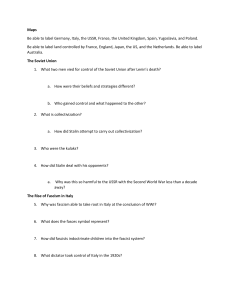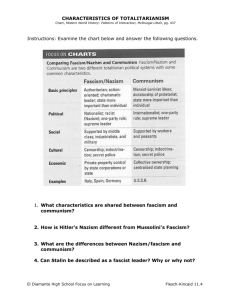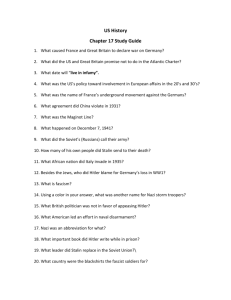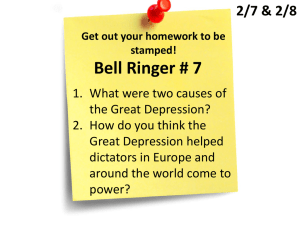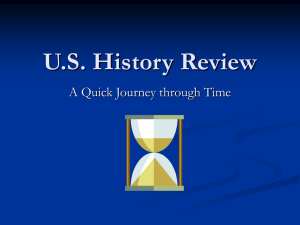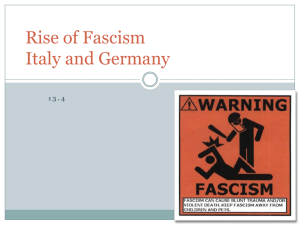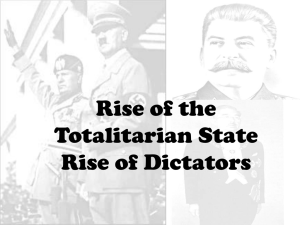Totalitarianism - Kenston Local Schools
advertisement
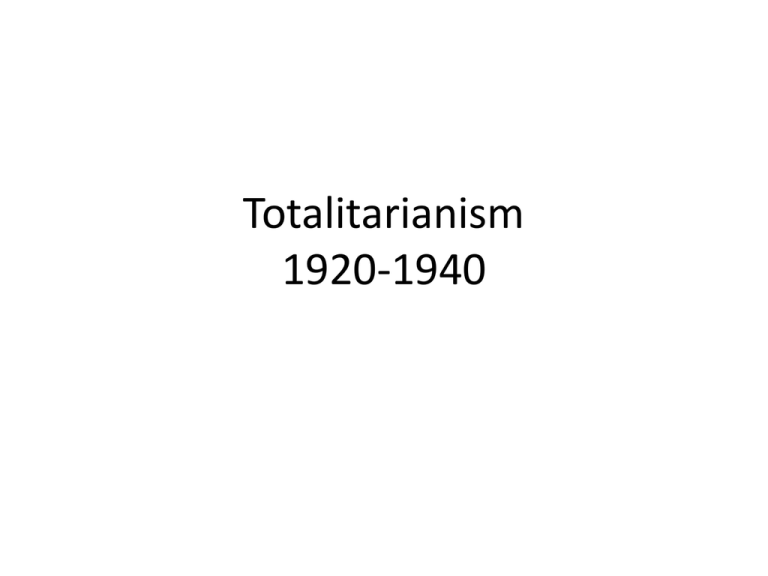
Totalitarianism 1920-1940 Totalitarianism v. Absolutism Totalitarianism • People expected to participate in government • Technology • Wiretap, coordination , propaganda, mobility • Censorship • Indoctrination • Terror • Either fascist or communist Absolutism (Conservative Authoritarianism) • Anti democratic • Prevent major change • Little to no participation in government • Sought the status quo • Limited in power & in objective • Came back after WWI, except Czech, Austria, Bulgaria, Romania, Greece, Estonia, Latvia Fascism v. Communism Fascism Communism • Glorification of the state • Single party; single ruler (dictator) • Condemns democracy: rival parties destroy unity. Man is unable to successfully govern collectively. • Supports the idea of capitalism & owning of private property so long as it serves the needs of the state • Corporate State: captains of industry become state economic deputies • World wide "dictatorship of the proletariat" (classless society) • One party (communist) under the control of the Politburo. Dictatorship is not the final goal. • Condemns capitalism for exploiting workers (“haves” vs. “have nots”) • Government controls all means of production (industrial & agricultural). No private ownership. • Economy is centralized under the communist party Fascism v. Communism Fascism Communism • Aggressive nationalism • Advocates Social Darwinism (powerful states control weaker ones) • Believes desire for peace shows weakness of gov't • Glorification of war (military sacrifice is glorified) • Emphasizes the inequalities among humans • • • • • Spread of communism for the benefit of the world's working class (Comintern) Condemns imperialism: advocates a world without nationalism with the workers united Peace is the ultimate goal Violent revolution to bring about the "dictatorship of the proletariat." War is not the end but merely the means. Emphasizes the perfectibility of society. Mankind is basically good. Soviet Union (USSR) • Lenin – No imperialism – Educated, professional revolutionaries – Revolution from above – World wide revolution – COMINTERN – War Communism – Cheka – Kronstadt Rebellion Soviet Union (USSR) • Lenin – NEP – “necessary step backwards” – Soviet Union, USSR – 1924, power struggle Soviet Union (USSR) • Stalin – Socialism in one country • Trotsky – Permanent revolution Soviet Union (USSR) • Stalin – 5-year plans – “Revolution from above” – Collectivization – Kulaks – Central Committee – Politburo – General Secretary Soviet Union (USSR) • Stalin – Propaganda – Benefits for workers – Women – The Great Terror – Show trials – Old Bolsheviks – Purges – Gulags The Fasces Symbol Fascist Italy • Causes • Benito Mussolini, Il Duce – Fascist Party – Blackshirts – March on Rome • Corporate State – Everything in the state, nothing outside the state, nothing against the state Fascist Italy • • • • • Mussolini creates a dictatorship Never truly became a totalitarian regime Women in Italy Accomplishments Legacy The Lateran Treaty The Fascist Family The Fascists encouraged the development of large families. Education • The first sentence pronounced by children at school was Let us salute the flag in the Roman fashion; hail to Italy; hail to Mussolini. • Textbooks emphasized: – The glorious pat of the ancient Romans. – The limitations imposed upon the present inhabitants by geography and the West. – The imperial destiny that awaited Italy’s future development. Anti-Semitism • 50,000 Jews lived in Italy in the 1930s. • Mussolini did NOT implement an extermination program in Italy. – 75% of Italian Jews survived World War II. – 8,000 died in German extermination camps. • 1938 anti-Semitic laws passed – Manifesto degli Scienziati Razzisti [The Manifesto of the Racist Scientists]. • Excluded foreign Jews [most of them were sent to German death camps]. • Forbade all Jews from teaching. • Excluded Jews from serving in the government or in the military. Mussolini Was Hitler’s Role Model Nazi Germany • Nazism • Aryan Race • Rise of Adolf Hitler – National Socialist German Workers Party (NAZI) – SA (Brown Shirts) – Beer Hall Putsch – Mein Kampf • Lebensraum Nazi Germany • Rise of Hitler – Fall of Weimar Republic • • • • Economic Social chaos Appealing Hitler became Chancellor 1933 Nazi Germany • The Third Reich – Hitler consolidates power • Reichstag fire • Enabling Act – Joseph Goebbles • Triumph of the Will – Night of the Long Knives • SA and SS under Heinrich Himmler Nazi Germany • • • • Gestapo Hitler Youth German economic recovery Nazi society Persecution of the Jews • • • • • • Enabling Act Nuremburg Laws 1935 Out of society 50% leave Kristallnacht Holocaust – – – – Exclusion Expulsion Enclosure Extermination


